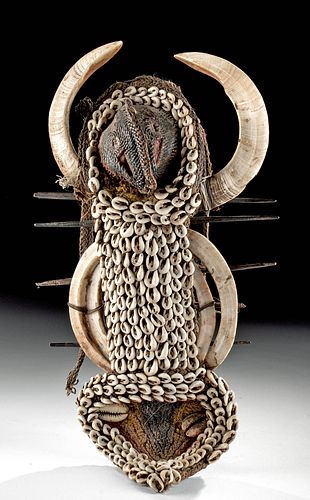20th C. Papua New Guinea Abelam Tusk & Shell Mouth Mask
Lot 84
About Seller
Artemis Gallery
686 S Taylor Ave, Ste 106
Louisville, CO 80027
United States
Selling antiquities, ancient and ethnographic art online since 1993, Artemis Gallery specializes in Classical Antiquities (Egyptian, Greek, Roman, Near Eastern), Asian, Pre-Columbian, African / Tribal / Oceanographic art. Our extensive inventory includes pottery, stone, metal, wood, glass and textil...Read more
Estimate:
$600 - $900
Absentee vs Live bid
Two ways to bid:
- Leave a max absentee bid and the platform will bid on your behalf up to your maximum bid during the live auction.
- Bid live during the auction and your bids will be submitted real-time to the auctioneer.
Bid Increments
| Price | Bid Increment |
|---|---|
| $0 | $25 |
| $300 | $50 |
| $1,000 | $100 |
| $2,000 | $250 |
| $5,000 | $500 |
| $10,000 | $1,000 |
| $20,000 | $2,500 |
| $50,000 | $5,000 |
| $100,000 | $10,000 |
| $200,000 | $20,000 |
About Auction
By Artemis Gallery
Nov 12, 2020
Set Reminder
2020-11-12 12:00:00
2020-11-12 12:00:00
America/New_York
Bidsquare
Bidsquare : Arms & Armor | Antiquity to Modern Day
https://www.bidsquare.com/auctions/artemis-gallery/arms-armor-antiquity-to-modern-day-6023
Specialty auction featuring axes, mace heads, swords, spears, various types of armor, and more! Many different cultures and price ranges. Great for first-time buyers, seasoned collectors, dealers, and that hard to buy for person on your holiday shopping list. Artemis Gallery info@artemisgallery.com
Specialty auction featuring axes, mace heads, swords, spears, various types of armor, and more! Many different cultures and price ranges. Great for first-time buyers, seasoned collectors, dealers, and that hard to buy for person on your holiday shopping list. Artemis Gallery info@artemisgallery.com
- Lot Description
Oceania, Papua New Guinea, North Maprik District, Abelam people, ca. first half of the 20th century CE. An abstract woven anthropomorphic effigy ornament called a karawut (also karahut or kara'ut). The elongated form is adorned with six boar tusks on the peripheries as well as dozens of petite cowrie snail shells along the front, and both fibrous masks - one on top and one below - are embellished with red, yellow, and black pigment. Five slender wooden rods pierce the mask from behind for additional structural stability. Size: 6.4" W x 12.875" H (16.3 cm x 32.7 cm)
The name karawut is quite literal, roughly translating to a hand-knotted twine object with boar tusks. When tribes in this region still engaged in warfare with their neighbors, these were worn by gripping them between the teeth in war, so that the enemy saw not a human, but a fierce creature armed with boar's teeth. It is important to note that among the peoples of Oceania, these objects are not just religiously symbolic themselves - the materials they are made of are also religiously symbolic, as well as the practices that artists in those communities go through to create them. This is why so much art from this area uses a wide variety of locally-available materials. The Abelam people, who live in the Maprik District, a densely rain-forested, hilly region, led agricultural lifestyles centered around growing yams and highly ritualized warfare with their neighbors. Beyond its cultural significance, this is a beautiful and striking piece of art, immediately recognizable as being from this little-visited part of the world.
Provenance: private Santa Fe, New Mexico, USA collection
All items legal to buy/sell under U.S. Statute covering cultural patrimony Code 2600, CHAPTER 14, and are guaranteed to be as described or your money back.
A Certificate of Authenticity will accompany all winning bids.
We ship worldwide and handle all shipping in-house for your convenience.
#157576Small chips to some boar tusks and shells, with light fading to pigmentation, and fraying in some woven areas, otherwise intact and very good. Great remains of pigment and earthen deposits throughout.Condition
- Shipping Info
-
All shipping is handled in-house for your convenience. Your invoice from Artemis Gallery will include shipping calculation instructions. If in doubt, please inquire BEFORE bidding for estimated shipping costs for individual items.
-
- Buyer's Premium



 EUR
EUR CAD
CAD AUD
AUD GBP
GBP MXN
MXN HKD
HKD CNY
CNY MYR
MYR SEK
SEK SGD
SGD CHF
CHF THB
THB















